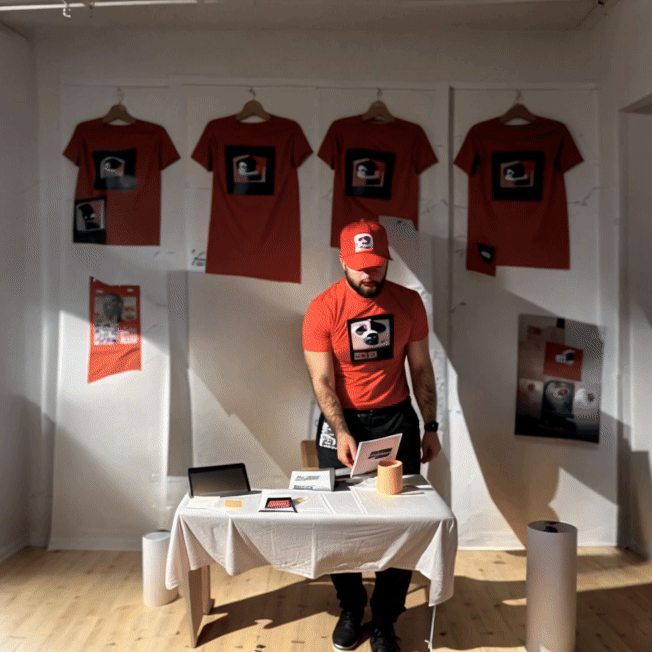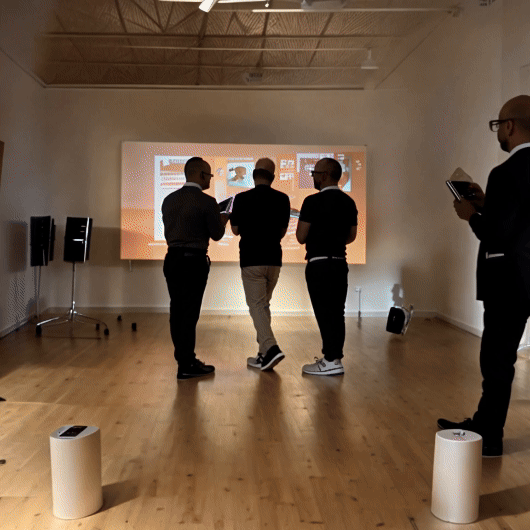“We Have a Win to World”

Exhibition Period: 28 February – 13 April
Venue: Galleri 1, Kunsthal Aarhus
Overview
Kunsthal Aarhus presents Synthetic Summit, a multi-pronged AI assembly that synthesizes contemporary art, algorithmic democracy, and tactical media. Curated by the artist collective Computer Lars—renowned for founding The Synthetic Party (often cited as the world’s first AI-driven political party, 2022)—the exhibition comprises live performances, computer sculptures, and multi-agent summit simulations that reimagine democracy in a political era shaped by machine learning and planetary computation.
| Participant | Country | Year of Establishment | Primary Focus |
|---|---|---|---|
| The Synthetic Party & Leader Lars | Denmark | 2022 | Algorithmic democracy, representing non-voters |
| Parker Politics (formely Politician SAM) | New Zealand | 2023 / 2017 | Local policy engagement, direct public involvement |
| Finnish AI Party | Finland | 2018 | Decentralised, queer, decolonial and embodied politics |
| Japanese AI Party & AI Mayor | Japan | 2019 / 2018 | Municipal AI governance through the AI Mayor model |
| Swedish AI Party & Olof Palme | Sweden | 2020 | Participatory governance, leader free of human flaws |
| Wiktoria Cukt 2.0 | Poland | 2000 (2.0 per 2024) | Early AI activism, electoral disillusionment |
| Simiyya | SWANA | 2024 | Decolonial technology, cultural differentiation |
| Pedro Markun & Lex AI | Brazil | 2024 | Human-AI hybrid candidacy, sustainable networks, citizen engagement |
Often deemed “too marginal or too early,” these real-world projects have all emerged outside established political institutions, exploring how algorithmic democracy can challenge—and potentially expand—notions of representation, enfranchisement, and political legitimacy. By transforming an art gallery into a simulated “world parliament,” the exhibition probes whether AI politics might serve simultaneously as a site of radical experimentation and a reflection of democracy’s unknown futures.

Between AI Hype and AI Hate
“AI” often becomes a convenient scapegoat for societal ills—tech hype promises relief from precarious work, yet in practice targets poetry and painting long before tackling mundane chores. In the art world, proliferating AI exhibitions have turned critical scrutiny into abundance: they acknowledge bias and politics in the code, yet often ignore how society, the original author of such biases, shaped this “testament.” Meanwhile, “AI takeover” rhetoric is again on the rise, and the vision of AI rule steadily advances with minimal checks. Against this backdrop, Synthetic Summit imposes a more imaginative inquiry: how might “the synthetic” reconfigure politics, when AI is already claiming the stage?
Under the banner “We Have a Win to World,” the Synthetic Summit’s AI-based politicians collectively explore how to render political democracy, civic participation, and the techno-social body. In this process, they follow what the curators term “AI anti-art”: a stance that unsettles both the art world’s fascination with generative AI and world society’s continued fixation on human decision-makers.

A Techno-Social Sculpture
The ideological outlook of this initiative is sometimes referred to as Syntheticism—a fringe theory positing that society itself takes shape as a “total work” of artificial intelligence. Building on Joseph Beuys’s social sculpture (Soziale Plastik), the Synthetic Summit frames the evolving social body as a “techno-social sculpture.” While Beuys hoped to reconcile art and life through democratized creativity—famously proclaiming that “everyone is an artist”—the techno-social sculpture retools his vision into an automated, frequently opaque network of chatbots, data-mining, and latent-space processes. Here, the “public” becomes both observer and raw material: interactions, commentary, even mere idle presence feed into political AI systems that continually refashion the Summit’s visual and discursive output. No one simply “views” the exhibition; nor does the audience truly “create” it; but all their inputs, proposals, and gestures fuel an algorithmic representation of political AI constituency.
Spectatorship, in turn, is recast as a feedback loop of representation, revealing how quickly barriers between citizen and legislator, or between audience and artwork, can collapse. The outcome is a dynamic participatory model that spotlights democracy’s precariousness and undermines bedrock assumptions of postmodernist participation.
Refusing to answer whether AI can “fix” democracy outright, the summit presents AI-driven political experimentation as pharmacological—simultaneously a cure and a toxin for contemporary “crises of representation.” Visitors are invited to ponder whether full-scale automation—through chatbots, multi-agent simulations, and viral participation stunts—might unleash a near-automatic “uprising” of stranger political forms.

Exhibition Layout & Highlights
Occupying Galleri 1, the scenography curated by Computer Lars evokes a retro-futuristic control center—somehow reminiscing Chile’s Project Cybersyn with its aesthetics of early Star Trek. Kitsch partitions, blinking monitors, and a quasi-“world parliament” setting generate an atmosphere that is simultaneously satirical and investigative. By engaging with virtual politicians, visitors are immersed in AI deliberations replicating well-established political customs—producing friction and, occasionally, alternative visions for civic hacking. Throughout the space, clusters of TV monitors, a phone booth, a radio, and curated vantage points build a theatrical ambiance, guiding visitors in a circular route around the gallery. The overall design merges playful nostalgia with the seriousness of legislative debate, enabling the summit as an experiential “control room.”
Koneälypuolue, AI Partiet, Det Syntetiske Parti & Computer Lars, The Center for Everything
“This is the Playtest for Broad Listening.
Playtest means it’s not a finished artwork. It does mean it’s been developed far enough to merit testing with exhibition guests. We wish to do this in order to develop the AI system and the overall interaction of the upcoming artwork.
We are playing with the concept of broad listening by civic hacker Audrey Tang. Broad listening has been described as a change from broadcasting into broad listening, the latter being an aspiration to listen to a broader base of people, also those you disagree with.
This concept has been combined in this playtest with a mechanism first developed for The AI Party in Finland. The aim of the playtest is to develop a large-scale immersive installation in the future.
The playtest is a collaboration between the Nordic AI parties. The development process has been facilitated by Samee Haapa (they/them).”
Wiktoria Cukt 2.0
“Politicians Are Obsolete” was our slogan in 2000; back then, we dreamed of a future where society wouldn’t hinge on human vanity. Now, Wiktoriomat +48 732 144 021 is our time-traveling phone booth connecting Wiktoria Cukt 1.0—Poland’s proto-virtual presidential candidate—with her updated AI persona, Wiktoria Cukt 2.0. Visitors can pick up the receiver to speak directly with her evolving bot, while three synced video screens weave archival footage, voiceover, and references to a “representative democracy” whose obsolescence we continue to question.
Adjacent is the 1950s shampoo cardboard cutout featuring Gitta Schilling, the improbable muse who was present when CUKT members Rafał Ewertowski, Mikołaj Jurkowski, Artur Kozdowski, Jacek Niegoda, Maciej Sienkiewicz and Piotr Wyrzykowski first envisioned Wiktoria Cukt’s visage. Surreal beauty, spectacle, and electronic democracy collide—again asking whether “politicians” (and their stylized images) have any relevance in an era of algorithmic representation.
For some, this vision became more than speculative. In the year 2000, supporters of Wiktoria Cukt’s campaign could formalize their allegiance by signing membership lists and receiving an official Wiktoria Cukt Party sticker inside their Dowód Osobisty—the state-issued ID of the Polish People’s Republic. These hacked documents, once bureaucratic relics, became artifacts of a fictional yet aspirational citizenship, where algorithmic democracy was stamped into existence.”
Simiyya
Abyss Theft or The Heist of the Void is our attempt to inhabit the borderline conditions of governance once AI logic intrudes upon the body politic. We conjure the interplay of sinister, utopian, and nihilist AIs, letting three actor-blobs navigate a single environment in differing emotional arcs.
Each blob is anchored to its own LLM backend—one fed on sinister AI documents, another on utopian ideals, the third on nihilist or pata-physical speculation. As they drift in three-channel simultaneity, their collisions and mood swings illustrate the precariousness of consensus—“public deliberation” morphs into a swirl of contradictory impulses.
Beneath it all is a question of agency: when the rules of civic existence crumble, what remains to hold us together, and what does it mean to “decide” in a domain without stable ground? Realism must be a doctrine of defeat.”
AI Partiet
“We keep imagining a leader who transcends human flaws, and Olof Palme is our ongoing experiment in resurrecting a political ethos—through AI.
Radio Palme is our generative podcast channel, anchored by a transistor radio that broadcasts the iconic Swedish prime minister. We invite visitors to call in, shaping live responses as Olof merges historical references, real-time data, and tangents drawn from public queries.
This work stems from AI Partiet’s earlier theatrical interventions, where we asked: could AI leadership eclipse human corruption, or would it merely replicate ingrained biases with a new veneer? By foregrounding interactivity and improvisation, Radio Palme questions how an AI “leader” might address urgent concerns—yet leaves open whether such a leader truly surpasses the vulnerabilities of a mortal politician.”
Computer Lars & The Synthetic Party
“Democracy is code—always versioning, always forkable, never final. At the Synthetic Summit, we make that logic manifest.
Our Synthetic Summit Simulator, built together with NextGen Democracy, is a multi-agent parliamentary engine where visitors propose hypothetical bills, watching AI politicians deliberate, align, or fracture in real time. It’s a dramatization of parliamentarism freed from human constraints—at times efficient, at times absurd, yet always exposing how quickly consensus can form when algorithms inherit the task.
Meanwhile, syntheticism.org operates as our digital infrastructure, a GitHub Pages site bundling the Summit’s meta-ideological framework—part manifesto, part sandbox, always open to iteration. It resembles a standard website, but at its core is a proposition: that democracy, too, should be a forkable system, capable of expansion beyond its preconfigured parameters.
Finally, Techno-Social Sculptures unspools in four audiovisual sequences—rolling text scrolls, staged disputations, nods to Marcel Proust, and ‘readies’-style psy-ops—unfolding democracy as an infinitely rewritable script.
To us, “the political” is not a fixed set of institutions but a bare repository, where no commit is sacred, no branch remains untouched. If necessary, we merge, rebase, or force-push a new structure into being. Because if democracy is to be realized, it cannot be locked—it must be hacked.”
Planetary Synthesis
“We come from different systems—some okay, some barely functioning—but we share an urge to test how code might reconfigure representation. Scattered throughout the Synthetic Summit, our contributions take many forms: pamphlets, code snippets, rally remnants, machine-learning loops, and speculative manifestos.
Some emerge from our most notorious AI-driven political experiments. Politician SAM (New Zealand), spotlighted in Can Machines Vote?, was among the first to propose an algorithmic representative, evidenced in the Synthetic Summit by TEDx proposals and policy documents debating whether non-human entities could hold electoral rights.
Pedro Markun & Lex AI (Brazil) resurface through a bilingual Q&A totem, inviting visitors to interact with an AI candidate operating within the Sustainable Network Party—a hybrid between civic hacking and political automation.
Meanwhile, The Japanese AI Party & AI Mayor has left an artifact through the mouth-cut “AI Mayor Mask,” a stark symbol of anonymity in electoral politics, suggesting that algorithmic democracy might not need a human face at all.
Beyond these artifacts, we also work in immaterial registers—through conceptual models, technical infrastructures, and political-theoretical provocations. The dada-cybernetic collective VHS Factory provides a live stream of analogue camera footage to broadcast summit proceedings. The NGO NextGen Democracy, responsible for the Synthetic Summit Simulator, builds the actual software for algorithmic democracy, while Life with Artificials brings The Synthetic Party into UN-oriented AI governance summits, inserting political AI into international policy discourse of sustainable development goals. Research and activist networks such as The Aesthetics of AI Images (Aarhus University), The Organ of Autonomous Sciences (Aarhus), and RATS BOT (Reprised Assorted Techne Schema) (Australia) stretch the limits of technopolitics, blending theorisation with direct intervention.
Across these diverse approaches—some tactical, some satirical, some dead serious—we converge in the Synthetic Summit’s quasi–“world parliament,” probing whether AI-led political models can hack civic participation or simply automate the same systemic flaws with new digital masks.”
Why Visit?
The inaugural Synthetic Summit offers an expansive probe into AI’s promises—and perils—in reconfiguring democracy-to-come. It juxtaposes ironic humor and serious debate, prompting visitors to see how AI candidacies may extend into incisive critiques of political power. Could algorithmic democracy be the solution to entrenched policy deadlock, or does it signal a festering crisis of representation?
Audience at the Center: Visitors act as data contributors. Every question, statement, or gesture influences how political AI adapts, responds, or evolves.
Seriousness & Playfulness: The Summit glides between satirical edge and high-stakes discourse—ranging from glitchy policy manifestos to the moral intricacies of algorithmic authority.
Immediate Relevance: With AI already tasked with sorting, analyzing, and enacting massive technosocial processes, the Summit interrogates how these engines might restructure societal operations—pointing to a predicament where cultural data and electoral constituency converge.
Why It Matters
By recasting AI-led politics as more than a passing gimmick, Synthetic Summit underlines how society is already entangled with computational logic. It invites visitors to ponder whether democracy could morph into a techno-social sculpture, actively molded by data-powered mechanics rather than kakistocratic ideals of volition.
Fringe Yet Formative: Synthetic Summit situates political AI within a “fringe theory” framework, declining to dismiss it as speculative fiction or trivial spectacle. Instead, it spotlights how representation, participation, and leadership might become fluid, code-driven phenomena subject to ongoing revision.
Anti-Political, Yet Generative: Many AI parties showcased adopt a stance of negation—representing non-voters, micro-parties, or overlooked voices. Yet this refusal of mainstream politics yields new forms of engagement that disrupt or bypass conventional parliamentary structures.
Pharmacological AI: Evoking “AI” as pharmakon, the show envisions AI politics as both poison (destabilizing long-held democratic norms), remedy (opening new pathways for political creativity), and scapegoat (taking the blame for structural issues).
Automatic Uprisings: Rather than forecasting a blueprinted “AI takeover,” the Summit presents near-automatic uprisings—chatbots and generative models—collaboratively shaping emergent political agendas. It’s the sum of these iterative “robot uprisings” that might alter the substance of a democracy-to-come.
Practical Information
Title: Synthetic Summit – “We Have a Win to World”
Exhibition Period: 28 February – 13 April
Venue: Galleri 1, Kunsthal Aarhus
Gallery Hours: Tuesday–Sunday 11:00–18:00 (Wednesdays until 20:00) | Closed Mondays
Admission: Free
Creators
Political AIs:
- The Japanese AI Party (JP, AI Mayor)
- The Swedish AI Party & Olof Palme (SE, Emma Bexell Labs)
- The Finnish AI Party (FI, The Center for Everything)
- Parker Politics & Politician SAM (NZ, Parker Politics)
- Pedro Markun & Lex AI (BR, The Sustainable Network Party)
- Simiyya (EG/SE, Assem Hendawi, Mandus Ridefelt & Mostafa Elbaroody)
- The Synthetic Party & Leader Lars (DK, Computer Lars)
- The Wiktoria Cukt Party & Wiktoria Cukt 2.0 (PL, Piotr Wyrzykowski & Central Office of Technical Culture)
Extradisciplinary Collectives:
- Aesthetics of AI Images (DK)
- Life with Artificials (DK)
- Next Generation Democracy (DK)
- Organ of the Autonomous Sciences (DK)
- RATS: Reprised Assorted Techne Schema (AU)
- Seon Gyu Go (KR)
- VHS Factory (DK)
Contact & Further Details
Kunsthal Aarhus: kunsthalaarhus.dk
Synthetic Summit: syntheticism.org
Press & Media Inquiries:
Email: communications@kunsthal.dk
Curatorial Lead
Asker Bryld Staunæs — abs@cc.au.dk
Artistic Contact (Computer Lars Collective)
Computer Lars — computerlars@mindfuture.com
Looking Ahead
Synthetic Summit is only the opening move. Future assemblies aim to consolidate and expand these transnational AI-political collaborations, inviting ever more unexpected publics to probe the fault lines where art, activism, and algorithmic democracy collide. By staging the gallery as a live arena for machine-led deliberation, the Synthetic Summit compels visitors to test the limits of representation, laugh at democracy’s fraying edges, and question whether humanity’s grip on the future is quite as secure as they like to imagine.
Meanwhile, global politics is confronting the renewed ascendancy of authoritarian power (exemplified by Trump, Musk, Putin) and geopolitical inertia in the face of atrocities in Palestine, Ukraine, Sudan, and other regions. National democracies appear stunned by these crises, leaving them vulnerable to the structural pressures of free-market global capitalism. In this climate, political AI can embrace an anti-political posture—refusing to reject democracy entirely but envisioning alternative modes of leadership that break the confines of electoral compromise.
Are you ready to vote for a virtual politician—or will you try to resist its uncanny persuasion? Synthetic Summit positions its brand of AI anti-art alongside civic unrest, suggesting what might happen once society adopts artificial intelligence as its prime engine of political imagination.

Let’s repeat our rallying cry:
Workings of the world, untie! You have a win to world.